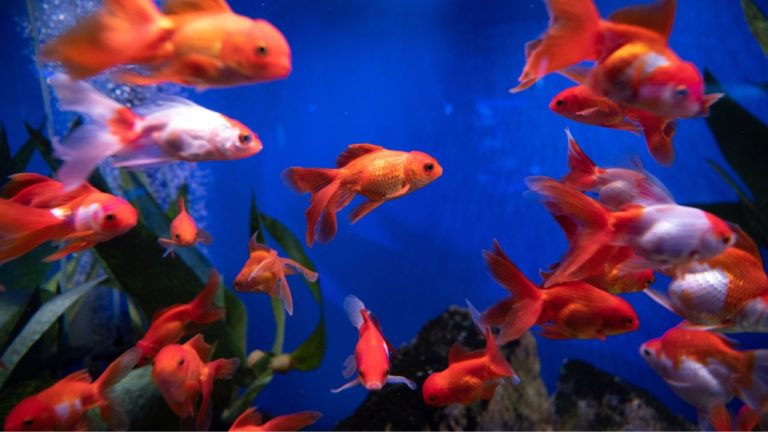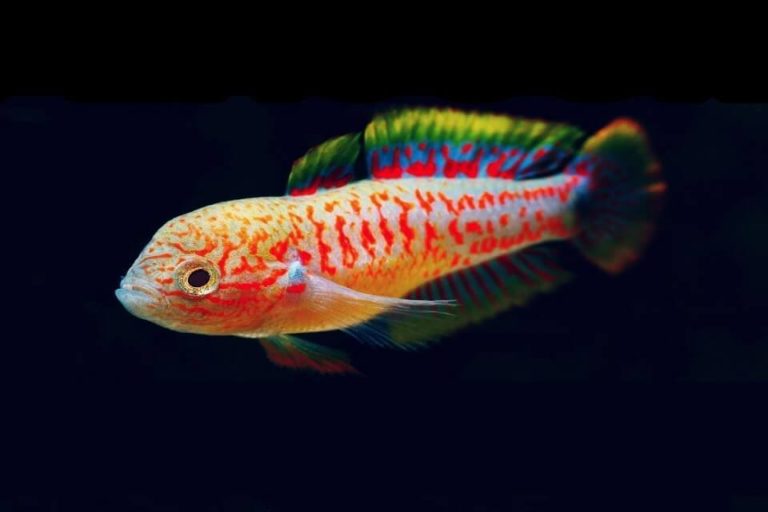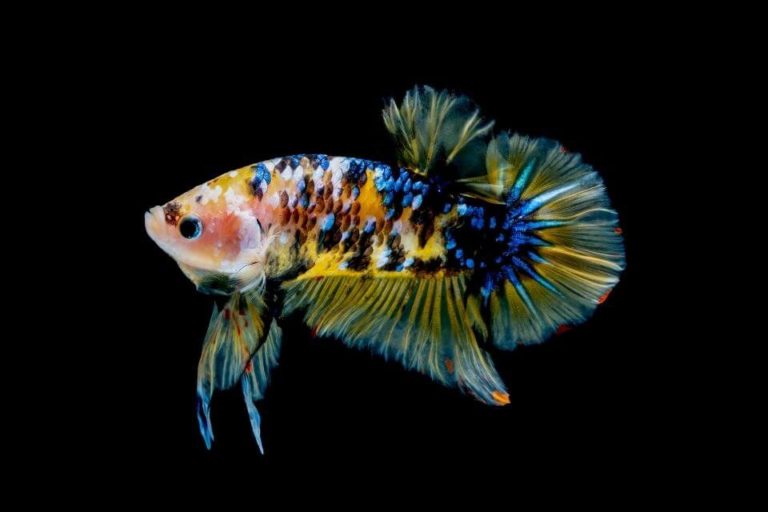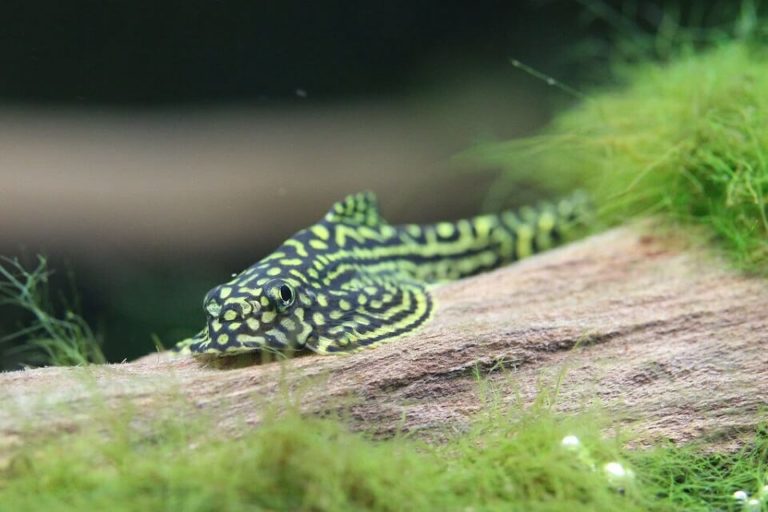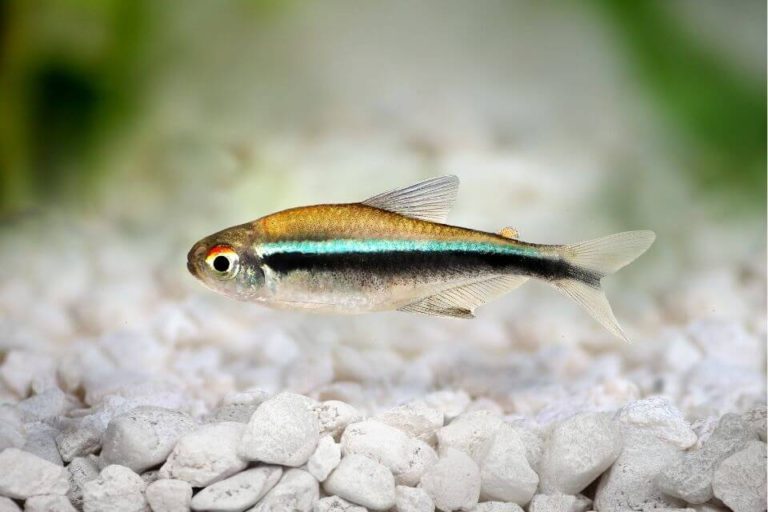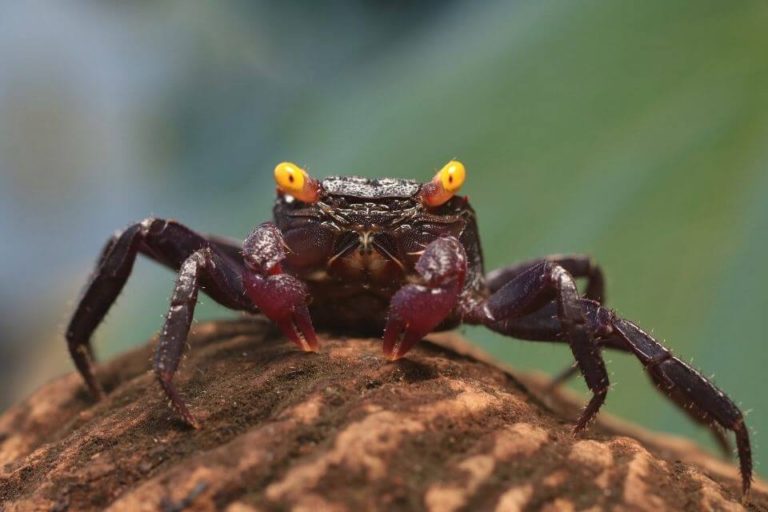Firemouth Cichlid Care Guide: Size, Diet, Breeding and Tank Conditions

Consider adding a fishtank with Firemouth Cichlid that improves your living room aesthetic. This fiery fish species is easy to look after, making it ideal for beginners. It is hardy and gentle fish species, allowing you to add other tankmates that make your freshwater tank colorful.
Just imagine relaxing in your living room as you watch this beautiful fish play in the aquarium. This care guide will provide you with all the nitty-gritty of keeping this stunning fish, from tank conditions and set up, water parameters, tankmates, breeding, to food and diet.
| Quick Facts: | |
|---|---|
| Common Names | : Firemouth Cichlid |
| Scientific Name | : Thorichthys Meeki |
| Family | : Cichlidae |
| Origin | : Rivers in Yucatán Peninsula, Southeastern Mexico |
| Care Level | : Beginner |
| Lifespan | : 8 - 10 years |
| Size (average) | : 5 - 6 inches long |
| Diet | : Omnivores |
| Breeding | : Egglayer |
| Social | : Territorial |
| Temperament | : Semi-aggressive |
| Minimum Tank Size | : 30 gallons |
| Temperature | : 75 - 86° F (23 - 30° C) |
| Water Hardness | : 8 - 15 dGH |
| Water pH Level | : 6.5 - 8 |
Overview of Firemouth Cichlid
Firemouth Cichlid is scientifically known as Thorichthys Meeki. This vibrant fish species is a member of the Cichlidae family and is native to Central America.
This fish was originally found in the rivers that span across the Yucatán Peninsula in Mexico. They can also be found in Belize, Costa Rica, Nicaragua, Honduras, and Guatemala. It is categorized as an invasive species because it is found in other areas worldwide, such as North America.
Because of its adaptive skills and fast growth rate, this fish can also be found in other countries such as the Philippines, Australia, USA, Isreal, and Singapore.
Thorichthys Meeki thrives in slow-moving rivers, streams, ponds, and canals with sandy and muddy bases. They are mostly found along the shores, where there is plenty of vegetation enabling them to feed on algae and other meaty foods.
Thanks to its vibrant coloration, Firemouth is quite popular in the aquarium market, and it is bred for commercial purposes. Because the female fish lays a large number of eggs, this fish species is not on the endangered species list.
This beautiful fish is peaceful, making it an ideal addition to a community tank. However, it’s best to separate the pair during spawning because they can be quite aggressive and territorial. Firemouth Cichlid can live up to an average range of 8 to 10 years under optimal conditions.
Some expert aquarists reported that they were able to keep Thorichthys Meeki up to 15 years with optimal care and supreme tank conditions.
Firemouth Cichlid is easy to take care of, and their peaceful natures make it easy to find tankmates.
Origin, Distribution, and Availability
Firemouth Cichlid was initially found in the slow-moving rivers of Central America. The scientific name meaning is divided into two parts; Thorichthys is an ancient Greek name meaning, leaping fish. Meeki was the expert Ichthyologist Seth Eugene Meek, who wrote the book on Mexican freshwater fish.
Human error and the hardy nature of this fish species make it possible to find this in various parts of the world, apart from its native habitat, provided that the water is slow-moving and cloudy. Because of its beautiful coloration, Firemouth is now bred for commercial purposes and made available in the aquarium market worldwide.
If you want this stunning fish species in your fish tank, visit your nearest local pet store, or you can buy online from reputable suppliers and have them delivered to your doorstep.
Look for healthy fish indications such as coloration, activity level, fin development, and non-distressed breathing. This helps avoid introducing sick fish in your tank as it threatens the lives of the tankmates.
Firemouth Cichlid Typical Behavior
Firemouth Cichlid is a peaceful fish that turns aggressive and territorial during the spawning period. Although they are not schooling fish, it’s recommended that you keep a pair (male and female) as they enjoy having the company of their fellow mates. It also makes breeding easy.
This beautiful fish is a role model for relationships and parenting because they are monogamous and are wholly committed to protecting and caring for their fry. They are very active and move things around the tank. So when you are decorating your aquarium, choose items that will not cause damage and hardy plants.
Characteristics of Firemouth Cichlid
Appearance
In terms of appearance, male and female Thorichthys Meeki have some differences, such that the male can grow up to 6 inches while the female is about 4.5 inches. The fish has a greyish-blue hue, and during spawning, the male develops a bright red orangeish color.
On their sides, you will notice dark stripes. The males also have longer fins, with the females having larger and rounded abdomen.

Colors and Special Markings
Firemouth Cichlid gets its name from its bright red hue that is more visible in the males than in females during spawning. The fish’s fins have a tinge of red around the edges and on their neck, gill covers, and abdomen. Some blue spots are visible on the anal fin’s surface and a black spot on their opercles.
You will notice black stripes on the sides, which adds a beautiful contrast to the light-gray to olive-gray body. Mature Firemouth Cichlid’s body turns violet. The fish’s eyes are blue with black pupils.
Their color depends on their origin; Firemouth Cichlid from Central America has brighter colors than those from other regions.
Size: How Big Do Firemouth Cichlid Get?
The size of male and female adult Thorichthys Meeki varies. Male grow up to 6 inches while females reach around 5 inches. They have a fast growth rate, so it takes a short time to reach their maximum size.
If you want your Firemouth Cichlid to get as big as possible, provide them with optimal conditions, meaning replicate their natural habitat to the letter.
Lifespan
Firemouth Cichlid has a lifespan of about 8 to 10 years when provided with optimal tank conditions. In rare cases, this stunning fish has been reported to live up to 15 years.
Aquarium Care and Conditions for Firemouth Cichlid
Tank Conditions and Care
Firemouth Cichlid is a freshwater fish found in the rivers of Central, so when setting up the aquarium, you must replicate their native habitat. Their native habitat comprises slow-moving rivers, ponds, and canals. These water bodies have sandy and muddy river beds that make a perfect breeding ground for the fish. There are also plenty of plants, driftwoods, rocks, and caves that act as breeding and hiding places.
Although they are freshwater fish species, they can withstand water with a 10% saline composition; thus, it’s not surprising to find them in various parts of the globe. You also need to install a robust filtration system to keep the tank clean since Thorichthys Meeki is sensitive to ammonia and nitrogen build-up in the water.
Since they love staying along the shores, you must include enough plants in your tank. Ensure that the plants have a healthy root system. This prevents them from being dug up since Firemouth Cichlid loves to move things around and dig up the dirt. This vibrant fish is not very sensitive to sunlight, allowing you to place the tank by the window or having a lighting system fitted to your tank.
Firemouth Cichlid Tank Size
This beautiful fish needs a big tank because a single fish can be kept in a 15-gallon tank. It’s best to keep a pair because of breeding; therefore, you will need a bigger tank of 30 gallons. The more the fish, the bigger the tank you will require.
Tank Setup
Thorichthys Meeki’s vibrant colors, peaceful nature, and ease in maintenance have made it a favorite of many aquarists, both beginners and veterans. The fish’s active and playful personality will keep you entertained from the comfort of your living room or office.

Please follow the step-by-step process detailed below in setting up your Firemouth Cichlid tank.
- Although you can keep a single fish, Firemouth Cichlids love the company of their fellow species, so it’s best to keep a pair (male and female). Choose a 30 gallons tank.
- The most appropriate substrate for your tank is fine sand with plenty of hiding places such as logs, driftwoods, rocks, and artificial caves. The fine sand is because this fish species loves digging up the dirt, so coarse gravel would end up scraping the fish, causing injuries.
- Install a robust and efficient filtration system to your fish tank to prevent ammonia and nitrogen build-up, which can cause harmful effects to your tropical fish.
- Fill your fish tank to around 1 or 2 inches below the top using either a bucket or a hose.
- Ensure that your tank is outfitted with a heater. This is because Firemouth Cichlids thrives in warm water whose temperature is between 75 and 86 °F.
- Introduce live aquarium plants to your fish tank and leave enough space for the fish to swim around. Ensure that the plants have a robust root system because the fish loves rearranging and digging up the dirt. Such plants include Sagittaria. Also, ensure that the plants are light tolerant since Firemouth Cichlid is not sensitive to too much light. Place the plant at the perimeter and leave the center open to allow fish to swim. This is because Firemouth Cichlid is found along the shores in their natural habitat.
- Leave your filter running for the next few days to ensure it works correctly before adding fish to your tank.
- After testing flow, test the water to ensure that the pH and temperature are within the acceptable range.
- Slowly add Firemouth Cichlid to your tank. Follow the instructions given by the store.
Suitable Plants
The best plants to plant in your aquarium are Sagittaria and Anubias Nana because they have a strong root system, preventing these active fish from uprooting them.
Water Temperature and Parameters
Firemouth Cichlids thrive in warm waters whose temperatures range between 75 and 86 degrees Fahrenheit (23 to 30 °C). The water pH should be between 6.5 and 8.0.
Since this fiery fish species can survive in a range of water conditions, water hardness should average 8 to 15 dGH (Degree of General Hardness).
Diet and Feeding for Firemouth Cichlid
If you plan on keeping Firemouth Cichlid in your fish tank, you may wonder what to feed them? But like many other cichlids, Firemouth is not a fussy eater and will eat anything that comes their way, meaning that they will never go hungry.
However, this also presents a danger because if they eat something that does not go well with them, they may have food poisoning, which is a pretty big deal in fish. After all, it is not easily detected, leading to the fish’s death.
In their native habitat, Firemouth Cichlid feeds on crustaceans, such as cladocerans, organic detritus, copepods, mollusks, small invertebrates, and copepods. So, if you plan on using snails or shrimp as tankmates, rethink your tankmates because they will be turned into a meal.
On a closer look, you find the fish scraping through the substrate looking for food. It’s not surprising to see the fish gulping mouthfuls of the substrate.
Provide your fish with a well-balanced diet in an aquarium as it encourages its growth and color development. Firemouth Cichlids feeds on flakes, live, and frozen food. You may also include some vegetables like lettuce, zucchini, spirulina, and cucumber. You must provide this fish species with top-quality flakes and pellets.
The frozen and live foods comprise worms (bloodworms, tubifex worms, and earthworms), mosquito larvae, and brine shrimp. It is recommended that you feed your Firemouth twice in small amounts. You can also find them nibbling on the plants.
Since they are not picky about food, avoid overfeeding them and give them food to finish within a few minutes.
Buying live fish food will cost you a pretty penny, which not everyone can afford. Therefore, try rearing your own food in a separate tank.
Common Diseases
Like most fish, Firemouth is prone to freshwater diseases brought about by parasitic, fungal, or bacterial infections. The most common type is the Ich which is characterized by white spots found on the body, fin, and gills.
If your Firemouth has Ich, don’t fret because it is relatively easy to treat. Since this fish species can tolerate high water temperatures of up to 86 degrees Fahrenheit. Increase the temperature in your tank for a few days to get rid of the Ich. Alternatively, you can use copper-based medicine to treat your fish.
But prevention is the best medicine, so take good care of your fish’s diet and water conditions. Although not common, your Firemouth Cichlid might be affected by the following diseases; Malawi bloat, swim bladder disease, cotton wool disease, and gill flukes.

How Can You Tell If a Firemouth Is Male or Female?
If you are a Cichlid enthusiast, you know how difficult it is to distinguish between males and females as they both exhibit little or no sexual dimorphism. Fortunately, adult male and female Firemouth Cichlid have a few distinct features.
Firemouth Cichlid had red orangeish hues on their necks, abdomen, and gills, of which the male Firemouth Cichlid is brighter and more colorful than its female counterparts. You notice that the males are longer and grow up to 6 inches, while the females grow to about 4.5 inches.
Compared to the females, the males have longer, sharper, and pointier dorsal and anal fins. The genital papilla in males is also visible. And during breeding, females appear plumper and fuller than males.
Firemouth Cichlid Breeding
Firemouth Cichlids are the perfect role models for families because they are monogamous and awesome parents to their fry. Breeding a Firemouth Cichlid is effortless once you have the basics.
You start by buying a bonded pair from the start for your aquarium. If not, you can purchase several balanced (male and female) and put them in the tank, and leave them to pair themselves in the tank.
Although you don’t need to make significant alterations to the fish tank, prepare for breeding by ensuring that the fish has some flat parts to lay the eggs. Then adjust the water pH to between 7 and 7.2, and the temperatures should hover around 80 degrees Fahrenheit. And the water hardness should be about 10dGH.
Female Firemouth Cichlid lays about 100 to 150 eggs, and then the male fertilizes them. The female stays close to the eggs while the male swims around the eggs warding off other fish. Firemouth can breed several times a year, so you don’t have to worry about this fish species becoming extinct.
The fry can feed on anything small, such as micro worms and Artemia nauplii.
The juveniles are ready to swim independently within a week, but the parents do not shack their responsibilities as they continue to protect and feed them. Ensure that you have made proper arrangements before breeding, such as an extra tank, because of the large number of fish.
Firemouth Cichlid Tank Mates
Firemouth Cichlid is a gentle and peaceful fish species unless they are protecting their fry because they can maim and kill other fish that threatens their juveniles’ lives. This makes them a perfect fish for a community tank.
If you have an enormous tank, then you have a wide range of tankmates to choose from. The most important part is to keep tankmates of the same size as Firemouth.
Although male Firemouth Cichlids are susceptible to harassment from other larger and aggressive tank mates, females make friends and get protection from other fish in the tank. The best tankmates for this vibrant and peaceful fish are those that move in a group, such as.
- Rummy Nose Tetra
- Clown Pleco
- Kuhli Loach
- Rainbowfish
- Swordtails
- Bristlenose Pleco
- Cory Catfish
- Platies
Do not put snails or shrimp as tankmates as they will be turned to food by Firemouth Cichlids.
Can Firemouth Cichlids Live with African Cichlids?
No. African Cichlids are aggressive and sometimes territorial, making them a danger to the peaceful Firemouth. Although some aquarists have had them in the same tank, the number of bad ending between the two species far outweighs the successful one. So, it’s best to keep the two fish species in separate tanks.
Are Firemouth Cichlids Aggressive?
Despite it coming from a family of aggressive fish species, Firemouth Cichlid is a peaceful fish. But during spawning, the fish become pretty aggressive, such that they can injure and kill any fish that threatens their spawns.
Therefore, it would be best to keep them in a separate tank during breeding to protect the tank mates. Or you can keep them with other Cichlids during this period.
Will Firemouth Cichlids Eat Other Fish?
Yes, they will. Firemouth Cichlid does not attack other fish, and that is why it is suitable for a community tank with the same size tank mates. However, if you put small-sized fish in the tank, be sure that they will not be turned into prey for this beautiful fish. So, I recommend not to keep tiny fish species with Firmouth Cichlids.
Do Firemouth Cichlids Eat Plants?
Yes. Firemouth Cichlid is omnivorous, meaning it feeds on both plants and animals. More so, its’ diet comprises vegetables such as lettuce and zucchini.
Do Firemouth Cichlids Have Teeth?
Yes. They have very sharp teeth in their upper and lower jaw and throat. They also have incredibly sharp spines. And their fins are pretty sharp too.
How Many Firemouth Cichlids are Kept Together?
Suppose you want to keep this fiery fish in your fish tank. It is recommended that a single Firemouth Cichlid should be kept in a 15 gallons tank. Although they are not schooling fish, they love the company of the same fish species; so consider putting a pair (male and female) in a 30 gallons tank. And increase the size of the tank if you want to keep more Firemouth Cichlids.
Can We Put Firemouth Cichlid with Other Cichlids?
No. It is recommended that you keep only one type of cichlid in one tank. Why? Because aggressive ones might bully non-aggressive Cichlids.
In Conclusion, The Firemouth Cichlid is a Better Choice for Your Freshwater Aquarium
Firemouth Cichlid is a peaceful and easy to maintain fish species, making it perfect for beginners. Their vibrant colors make them a beautiful addition to your freshwater aquarium. The best news is that they can co-exist with different fish species of the same size.
By now, we believe you have sound knowledge for taking care of Firemouth Cichlid by reading this care guide. Make yourself busy and start setting up a freshwater tank in your space.
If you have any questing that we did not discuss here, feel free to ask them in the comment section below. We are here to help you out.


